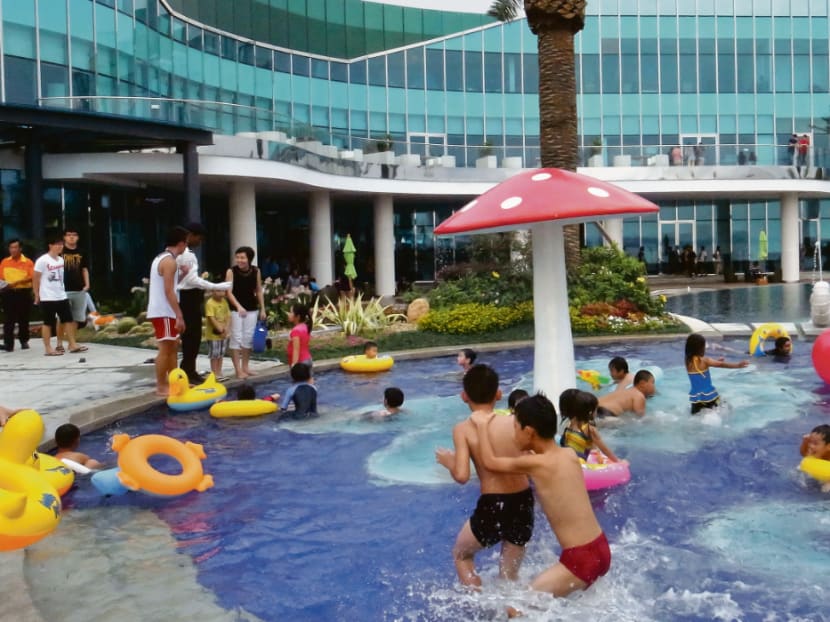Private pools a high-risk area as drowning cases among children go up
SINGAPORE — More children nearly drowned — and in some cases, died from drowning — in the past five years compared with the previous six years, and many of these cases happened in condominium pools, based on cases seen at KK Women’s and Children’s Hospital (KKH).
SINGAPORE — More children nearly drowned — and in some cases, died from drowning — in the past five years compared with the previous six years, and many of these cases happened in condominium pools, based on cases seen at KK Women’s and Children’s Hospital (KKH).
The hospital saw 94 near-drowning incidents between January 2011 and December last year involving children from below a year old to 15 years old, and 10 drowning cases.
This is about 17 to 27 submersion cases every year, the hospital said, compared with between one and 14 cases each year between 2005 and 2010.
It was unable to provide consolidated figures for 2005 to 2010.
More than half of these incidents also occurred in condominium pools — 54 cases — the most at any location. All 10 drowning deaths over the past five years took place in private pools such as at condominiums, private homes or hotels, with half of them happening during pool parties.
As a result, a child is eight times more likely to die from drowning if he or she is at a pool party, KKH added. In Singapore, it sees about 80 per cent of submersion injuries involving children.
Sharing these figures at a media conference on Thursday (March 10), Dr Arif Tyebally, deputy head of KKH’s emergency medicine department, said this “worrying upward trend” could be due to factors such as a lack of vigilance from parents and caregivers, rising affluence — more people living in condominiums — and even the design of swimming pools. For example, pools with “unique shapes” surrounded by trees and plants may block the line of vision between a caregiver and the child.
“(This trend) is disturbing as we know that all these incidents could have been prevented. Drowning deaths can occur within minutes and even if the child survives, there may be permanent brain damage,” he added.
In two cases seen by KKH, the children survived but suffered hypoxic brain damage, an irreversible condition due to oxygen deprivation to the brain.
Drowning ranks among the top three causes of “death by unintentional injuries” for children, the other two being road traffic accidents and falls.
Children aged six years and below were found to be at the highest risk, accounting for more than 76 per cent of the incidents. And boys make up about two-thirds of these cases.
The hospital is in discussions with the Health Promotion Board to work on further materials, such as a mobile application to educate parents on the dangers of childhood drowning incidents.
It is also providing information on prevention of childhood injuries to expectant mothers during prenatal talks. Recent cases involving children include a seven-year-old boy who drowned at the Hard Rock Hotel at Resorts World Sentosa last June, when he entered a section of the pool deeper than his height.
Parents whom TODAY spoke to said it was not uncommon to see parents or caretakers distracted from their children at condominium pools which typically do not have lifeguards. Preventing such incidents, they felt, lies with parents.
Ms Felicia Ong, 31, does not let her two-year-old son out of her sight when he plays in her executive condominium’s baby pool. While the water only comes up to his ankles or knees, she said even that could pose a danger and she keeps him “very close by”.
“I teach him to sense his space. When he goes into the pool he must feel the ground with his feet. If not, he sits down as he goes in to feel the base with his bottom,” the pastor said.
Madam Leraine Leow, 35, said her two primary school-age children swim in their condominium pool almost every day.
“In a few minutes, things can change. Parents should be more well-informed… whoever is looking after the child must be there at all times,” the part-time piano teacher added.
Singapore Life Saving Society president Richard Tan told TODAY that drowning is a “silent” killer. Children who are drowning cannot yell and shout, contrary to depictions in movies, and it could take just 20 to 60 seconds of struggling underwater for a child to succumb.
Mr Tan also said he has long urged the authorities to look into having lifeguards at condominium pools, noting there is currently no law mandating that lifeguards must be present at pools, beaches or any recreational body of water.
“That said, parents should always keep constant vigilant watch, not talk to other people while watching their children... parents don’t need to learn how to swim in order to learn lifesaving techniques like first-aid and CPR (cardiopulmonary resuscitation) too.”









